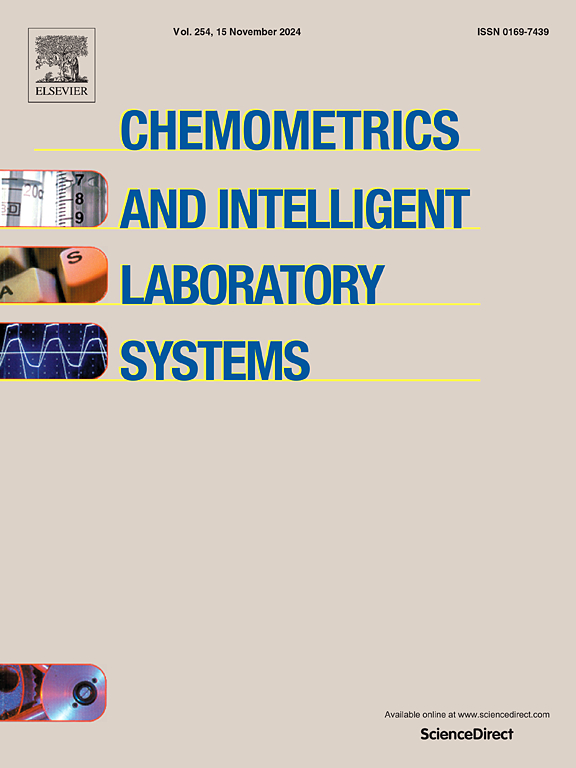Application of continuous wavelet transform and a novel hybrid approach based on discrete wavelet transform with principal component analysis and fuzzy inference system for the concurrent spectrophotometric analysis of cardiovascular drugs in biological samples
IF 3.8
2区 化学
Q2 AUTOMATION & CONTROL SYSTEMS
Chemometrics and Intelligent Laboratory Systems
Pub Date : 2025-06-03
DOI:10.1016/j.chemolab.2025.105460
引用次数: 0
Abstract
In this study, chemometric-assisted UV-spectrophotometric methods using continuous wavelet transform (CWT) and discrete wavelet transform (DWT) integrated with principal component analysis (PCA) and fuzzy inference system (FIS) were developed for the simultaneous determination of losartan (LOS) and diltiazem (DIL) in binary mixtures and urine samples without any separation process. In the CWT, the best zero crossing point was obtained through the Coiflet wavelet with an order of 2 (coif2) at a wavelength of 218 nm for LOS and Daubechies wavelet with an order of 2 (db2) at a wavelength of 242 nm for DIL. The linearity range was 1–9 μg/mL for LOS, while for DIL it was 6–18 μg/mL. The LOD was 0.5924 and 1.5416 μg/mL, while the LOQ was 1.7951 and 4.5454 μg/mL for LOS and DIL, respectively. The analysis of laboratory mixtures using CWT demonstrated mean recovery values equal to 98.07 % for LOS and 99.38 % for DIL, where the root mean square error was 0.2376 for LOS and 0.2523 for DIL. In DWT, the decomposition of absorption of mixtures was performed using biorthogonal (bior1.5), db2, and Demeyer (DM) at five levels, and their outputs were reduced via PCA. Their output was dimensionally reduced through PCA to serve as the input of the FIS. The wavelet of DM with mean recovery of 100.12 % and 100.02 %, as well as RMSE of 0.0075 and 0.0105 was selected as the best wavelet for LOS and DIL, respectively. The analysis of LOS and DIL in biological samples using the suggested methods indicated RSD<1.6 % and mean recovery >94 % and their results were compared to HPLC using the ANOVA test. It can be claimed that these suggested chemometrics methods with the help of spectrophotometry are economical, quick, easy, and reliable ways in quality control laboratories as an alternative to available techniques.
连续小波变换及基于离散小波变换与主成分分析和模糊推理系统的混合方法在生物样品中心血管药物并发分光光度分析中的应用
本研究采用连续小波变换(CWT)和离散小波变换(DWT)结合主成分分析(PCA)和模糊推理系统(FIS),建立了化学计量学辅助紫外分光光度法同时测定二元混合物和尿液样品中的氯沙坦(LOS)和地尔硫卓(DIL)的方法。在CWT中,对于LOS,在波长218 nm处采用Coiflet小波为2阶(coif2),对于DIL,在波长242 nm处采用Daubechies小波为2阶(db2),得到了最佳的过零点。LOS的线性范围为1 ~ 9 μg/mL, DIL的线性范围为6 ~ 18 μg/mL。LOS和DIL的检测限分别为0.5924和1.5416 μg/mL, LOQ分别为1.7951和4.5454 μg/mL。使用CWT对实验室混合物进行分析,结果表明LOS的平均回收率为98.07%,DIL的平均回收率为99.38%,其中LOS的均方根误差为0.2376,DIL的均方根误差为0.2523。在DWT中,使用双正交(bior1.5)、db2和Demeyer (DM)在五个水平上对混合物的吸收进行分解,并通过PCA对其输出进行约简。它们的输出通过PCA降维,作为FIS的输入。选择DM小波均值分别为100.12%和100.02%,RMSE分别为0.0075和0.0105作为LOS和DIL的最佳小波。采用该方法对生物样品中的LOS和DIL进行分析,rsd为1.6%,平均回收率为94%,并通过方差分析与HPLC进行比较。可以说,这些建议的化学计量学方法在分光光度法的帮助下是经济、快速、简单和可靠的方法,在质量控制实验室作为现有技术的替代方法。
本文章由计算机程序翻译,如有差异,请以英文原文为准。
求助全文
约1分钟内获得全文
求助全文
来源期刊
CiteScore
7.50
自引率
7.70%
发文量
169
审稿时长
3.4 months
期刊介绍:
Chemometrics and Intelligent Laboratory Systems publishes original research papers, short communications, reviews, tutorials and Original Software Publications reporting on development of novel statistical, mathematical, or computer techniques in Chemistry and related disciplines.
Chemometrics is the chemical discipline that uses mathematical and statistical methods to design or select optimal procedures and experiments, and to provide maximum chemical information by analysing chemical data.
The journal deals with the following topics:
1) Development of new statistical, mathematical and chemometrical methods for Chemistry and related fields (Environmental Chemistry, Biochemistry, Toxicology, System Biology, -Omics, etc.)
2) Novel applications of chemometrics to all branches of Chemistry and related fields (typical domains of interest are: process data analysis, experimental design, data mining, signal processing, supervised modelling, decision making, robust statistics, mixture analysis, multivariate calibration etc.) Routine applications of established chemometrical techniques will not be considered.
3) Development of new software that provides novel tools or truly advances the use of chemometrical methods.
4) Well characterized data sets to test performance for the new methods and software.
The journal complies with International Committee of Medical Journal Editors'' Uniform requirements for manuscripts.

 求助内容:
求助内容: 应助结果提醒方式:
应助结果提醒方式:


